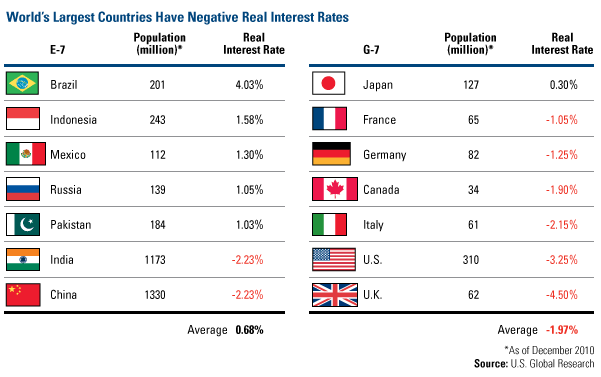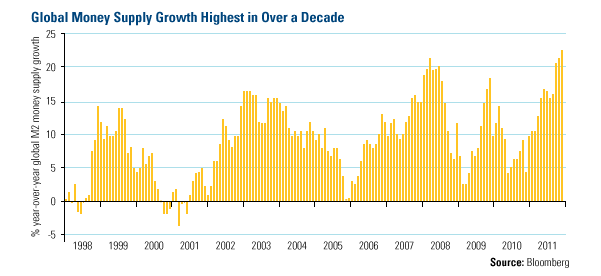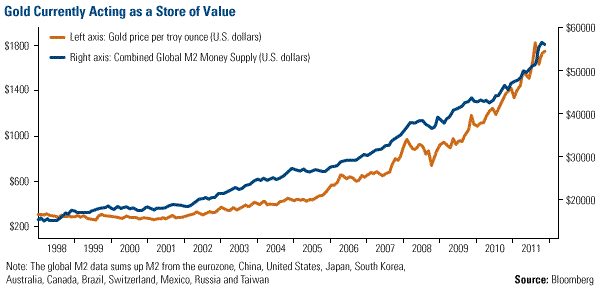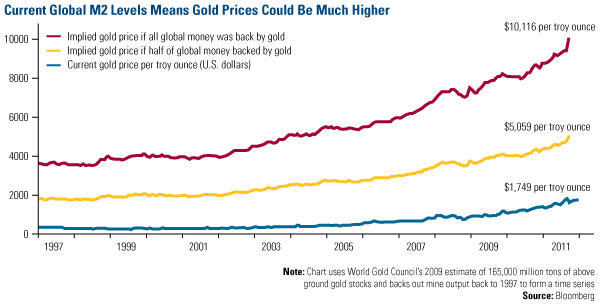You Can’t Print More Gold, Price Could Reach $10,000
Commodities / Gold and Silver 2012 Dec 10, 2011 - 02:55 PM GMTBy: Frank_Holmes
 What do you get when you mix negative real interest rates with stimulative money supply efforts by global central banks?
What do you get when you mix negative real interest rates with stimulative money supply efforts by global central banks?
An exceptionally potent formula for higher gold prices that could send gold to the unimaginable level of $10,000 an ounce. Negative real interest rates and strong money supply growth are two key factors of what I refer to as the Fear Trade.
Negative real interest rates occur when the inflationary rate, or CPI, is greater than the current interest rate. A quick account of the G-7 and E-7 countries shows that the majority have negative real interest rates.
Across the developed G-7 countries, British citizens are the worst off with real interest rates in the U.K. sitting at negative 4.5 percent.
U.S investors aren’t doing much better with rates at negative 3.25 percent and the Fed has all but guaranteed rates will remain there. Only Japan has a positive real interest rate among the G-7 and that rate is barely above zero.
Conversely, the most populous nations making up the E-7 have mostly positive real interest rates. However, the grouping’s grandest economic powerhouses, China and India, have negative real interest rates sitting around negative 2 percent.

Simply put, investors in those countries who have parked their savings in cash and low-yielding investments, such as Treasury bills and money market accounts in the U.S., are actually losing money due to inflation.
That can be tough for any investor, but when you’re the central bank of a country with millions of dollars in reserves, it can be catastrophic. This is why central banks around the globe have sought protection by diversifying their foreign-exchange reserves into gold bullion this year.
VTB Capital’s Andrey Kryuchenkov told The Wall Street Journal this week that, “Central banks are diversifying, and it has intensified to a rate that nobody had expected.” Latest estimates predict global central banks will purchase between 475-500 tons of gold in 2011.
This amount of capital flowing into gold has the potential to push prices up a level in 2012. John Mendelson from ISI Group sees gold prices reaching $2,200 an ounce during the first six months of 2012.
While real interest rates look to remain in the red for the foreseeable future, many of these same countries are printing record amounts of “green” with accommodative monetary policies.
U.S. Global’s director of research John Derrick says central banks around the world have focused their attention on stimulating growth. Beginning with Brazil’s interest rate cut in late August through the European Central Banks (ECB) cut this week, there have been 40 easing moves by global central banks, according to ISI Group.
John says this also means we will likely see more quantitative easing in 2012. The Bank of England has already started its quantitative easing, and many experts believe the ECB and the Federal Reserve will follow in its footsteps.
Bloomberg reports that global money supply (M2) is “set to increase the most on record in 2011.” The chart below shows the year-over-year change of global money supply has been gradually moving higher and higher since mid-2010.

The reason global central banks have shifted the printing presses into overdrive is simple: they need the money. My long-time friend Frank Giustra reminded us of this new reality in an op-ed piece for the Vancouver Sun last week. Frank writes:
“The bottom line is that the money needed to bail out Europe and to fund America’s spiraling debt and future unfunded obligations is in the ten of trillions. IT DOES NOT EXIST. It has to be created by printing money in massive quantities, and despite all the rhetoric you will hear against such policies, in the end it’s the path of least resistance. Printing money is an invisible tax on savings, much easier to initiate, than, say, raising taxes or cutting back on services and entitlements.”
As central banks print money and increase supply, currencies become devalued. Whereas in the recent past, one currency may be reduced in value compared with other currencies, this time there is global competitive devaluation as excess liquidity is put into the system. Historically, this excess liquidity has made its way to riskier assets, i.e. stocks and commodities.
Gold is generally a benefactor of this flight to riskier assets as many investors see it as a store of value. This chart illustrates the interconnectivity of gold and global money supply growth.

However, this image doesn’t tell the whole story. While the price of gold has followed the same upward path as money supply over the past 14 years, it hasn’t been able to keep pace with M2 growth, says the Bloomberg Precious Metal Mining Team.
In fact, if the global money supply were backed by gold, gold prices would be much higher, according to Bloomberg. The yellow line below shows how gold would be greater than $5,000 per troy ounce if just half of global money supply were backed by gold. If all of the money supply in the world were to be backed by gold, the price of one troy ounce would need to rise above $10,000.

It’s unlikely, of course, that this will happen, but it serves as a useful illustration for the disappearing value of the world’s fiat currencies.
Frank reminded readers that we have been down this path before. Frank says, “When great nations mature and over-extend themselves, they revert to the paths of least resistance: borrow and/or print money. They all did it and they all failed; this time will be no different.”
The beneficiary of this type of event has historically been gold.
U.S. Global Investors, Inc. is an investment management firm specializing in gold, natural resources, emerging markets and global infrastructure opportunities around the world. The company, headquartered in San Antonio, Texas, manages 13 no-load mutual funds in the U.S. Global Investors fund family, as well as funds for international clients.
For more updates on global investing from Frank and the rest of the U.S. Global Investors team, follow us on Twitter at www.twitter.com/USFunds or like us on Facebook at www.facebook.com/USFunds. You can also watch exclusive videos on what our research overseas has turned up on our YouTube channel at www.youtube.com/USFunds.
By Frank Holmes
CEO and Chief Investment Officer
U.S. Global Investors
U.S. Global Investors, Inc. is an investment management firm specializing in gold, natural resources, emerging markets and global infrastructure opportunities around the world. The company, headquartered in San Antonio, Texas, manages 13 no-load mutual funds in the U.S. Global Investors fund family, as well as funds for international clients.
All opinions expressed and data provided are subject to change without notice. Some of these opinions may not be appropriate to every investor.
Standard deviation is a measure of the dispersion of a set of data from its mean. The more spread apart the data, the higher the deviation. Standard deviation is also known as historical volatility. All opinions expressed and data provided are subject to change without notice. Some of these opinions may not be appropriate to every investor. The S&P 500 Stock Index is a widely recognized capitalization-weighted index of 500 common stock prices in U.S. companies. The NYSE Arca Gold BUGS (Basket of Unhedged Gold Stocks) Index (HUI) is a modified equal dollar weighted index of companies involved in gold mining. The HUI Index was designed to provide significant exposure to near term movements in gold prices by including companies that do not hedge their gold production beyond 1.5 years. The MSCI Emerging Markets Index is a free float-adjusted market capitalization index that is designed to measure equity market performance in the global emerging markets. The U.S. Trade Weighted Dollar Index provides a general indication of the international value of the U.S. dollar.
Frank Holmes Archive |
© 2005-2022 http://www.MarketOracle.co.uk - The Market Oracle is a FREE Daily Financial Markets Analysis & Forecasting online publication.



